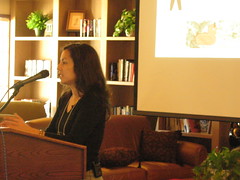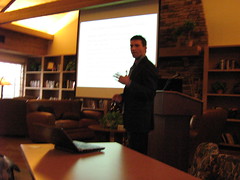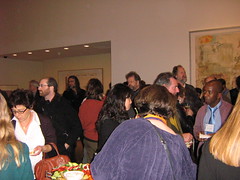Finally upgraded the WordPress Installation and am now tinkering with the theme. More soon. 🙂 Some of the things that look like they can be edited in the Theme Options page seem not to be changeable. Time to mess with the templates… Wheee!
Category Archives: Uncategorized
CCCC panel–Web 2.0 Wavelengths: Examining Spaces Created Within Electronic Discourse
Missed the first speaker–my stupid business center could not print my slides…. 😛
2 Jennifer Buckner spoke about using Pownce in her class. She analyzed her own interactions with students and in particular the way she teetered between speaking personally and speaking as teacher. I notice again how little Comp. and and Internet Research are not talking, because so many of the questions raised have been raised and explored already–which is not to discredit what she said, but rather to wish the larger conversation were more coherent and integrated.
I also wonder if she has read earlier research on networked writing classes–must find citations for those.
3 Deanya Lattimore now presenting “How I killed the Weblog.” She uses overheads in a really clever way to introduce her talk, which has changed from when she first proposed it. She used a multi-user WordPress blog–how does one choose that? It allows students to choose there own themes, but doesn’t encourage the kind of organization I can achieve with the magzine type theme I’ve used in my classes. –hypersuasion–
problems: no outward links, only internal. No comments.
Is it true that a paper-based essay wouldn’t allow the personal tone that a student uses in the blog’s “about me” page?
Seems Deanya emphasized too much what form an essay must take–not too much hyperlinking, for example. She also thinks this focus stifled comments and prevented the “working through ideas” characteristic of many blogs. In the end, she seems to have decided that it would have been better to not try controlling what students wrote, or how they wrote it. –That jibes with most work on fostering student engagement; students will feel more invested if they have more control.
Next time–the blog as portfolio, not essay.
And let the academic essay rest in peace.
4 Todd Finley –Microblogging as prof. development. Cites Alfred Wallace–developed theory of evolution in a fever dream, at the same time as Darwin, but was just a little too slow publishing.
How we socialized each other in that space–example of how the word “fuck” in is used in the space. How this community of teachers developed–mish mash of experiences. Rather messy auto-ethnography. Anxiety is ok–related to productivity, depression is not; you’re a slug. But bragginess isn’t ok either. Also depends whether you are positioned as a novice or experienced scholar.
No one talks about sex, no talk about spouses–no outside intimacies discussed in this group. Alliances are not discussed–who is closer who is less close. Academic debates are ok, but conflicts involving emotions are not discussed. No religion. So how much trust is there really? Sadly have to leave before discussion because it runs long and I speak in the next session!
Refer him to Jonathan Marshall and Shanyang Zhao about the body breaking out, emotional intimacy and co-presence. And I wonder if the speaker had permission from the other group members to discuss this at Cs.
Again, a lot of reinvention going on–confirms what I said at MLA about how fragmented research is right now, Deanya’s talk was the best and most useful-real analysis going on there, by someone who was NOT just cutting her teeth on social software.
Tiny Update on IR 9.0
Good conference so far– seen all interesting talks, but still so so jet-lagged. Really wish I could have come a day earlier to get more rest before it all started. Also, all European colleagues seem to have lighter workloads and more travel funding than I do…
I recorded the audio of our panel; will edit and post it next week and/or possibly coordinate it with slides for a podcast.
Review of Cyberfeminism in Northern Lights: Digital Media and Gender in a Nordic Context
This review will be coming out in a few months and once it does I’m not supposed to publish it elsewhere for a year! So here’s a sneak preview…
Malin Sveningsson Elm & Jenny Sundén (Eds.) (2007). Cyberfeminism in Northern Lights: Digital Media and Gender in a Nordic Context. Cambridge Scholars Publishing. isbn: 9781847180896. UK: £34.99 US: $69.99 295 pages
Malin Sveningsson Elm and Jenny Sundén launch this collection with the claim that other research on gender and digital media has been US and UK-centric, taking the experiences of people in those countries as universal and ignoring differences in the construction of gender and in the actual living conditions of men and women in other countries. As they point out, this blinkered view of gender and technology, and of cyber-feminism in particular, parallels the development of feminism itself. It is discouraging to think that the realization of a narrow view in the general case did not prevent a similar error in subsequent cyber-feminist studies, but this book offers a good example of the work needed to clarify our understanding. Further gaps the authors seek to fill are in providing a more critical view of technology and most importantly, solid empirical research on the intersections of gender and digital media.
The ten chapters are divided into three parts: “Sexualities, Bodies and Desire,” Gender Identities, Performance, and Presentation of Self,” and “Gendered Computing and Computer Use.” The cohesion even within sections is a bit loose because the editors aimed to include research from each of the Scandinavian countries, scrupulously avoiding the essentialism they critique. One common theme though is the ways discourse around gender and technology tends to make some users and practices visible and others invisible, and the way it constructs some users and practices as normal or positive, while others are placed firmly in a deviant or negative category. Because, as argued in the introduction, both gender and technology are socially constructed, understanding these discursive practices is essential to understanding the ways men and women perceive and use technology.
In Part One, Jenny Sunden considers “intersectionality,” which
has come to stand for research that explores the ways in which power relations, constituted in and through socio-cultural categories, such as gender, sexuality, race, and class, co-construct one another in multiple ways (32)
and how it may be applied to the study of technology and cyber-culture. This chapter serves to further illustrate the need for country specific work because by definition, an intersectionalist approach would be based in this specificity.
The next two chapters by Susanna Pasonen and Janne C.H. Bromseth are even more specific. Chapter Two explores what Finnish online pornography reveals about definitions of some sexual practices as good and others as less good. Passonen draws our attention past the usual critique of heternormativity to point out that pornography has been largely ignored by Nordic internet researchers because it is part of less good sexual practices, and that further, porn is inaccurately perceived as homogenous, thus making some sexual practices invisible and inaccessible to discussion or study. Chapter Three follows a debate that occurred in an online lesbian and feminist community over who counted as a “real” lesbian, demonstrating that in online communities as in offline, “hegemonies of identity, gender,and sexuality are also reproduced (93).” In particular, Bromseth teases out the discursive practices of online gender construction, and the ways this is shaped by the Scandinavian context which is characterized by (among other things) steady government promotion of equal rights, and a less adversarial relationship between men and women than found in studies of online culture in the US.
Part Two offers three studies of gender performance in online communities, some in which the performance is explicitly stated to be opposing stereotypes, and others in which representations of gender roles are conscious, but aimed at other purposes, such as what is believed to be historically accurate. These chapters are valuable in the way they document the actual practices of online community members, and in the close readings they offer of websites. For example, Sveningsson Elm’s study of Lunarstorm in Chapter Four illuminates the interaction between users, culturally bound gender stereotypes, and the hetero-normative design of the social networking site. Particularly interesting are the analyses of what information is included or excluded from personal pages, which often point toward stereotypes that are unconsciously fulfilled by the creator.
Charlotte Kroløkke studies players of the Danish online game Powerbabes in Chapter Five; in this game all characters are female, but players are both male and female. As Kroløkke finds, they find ways to co-opt the games affordances and both feminist agency and cultural production can be seen. In the last chapter of the section, Six, Åsberg and Axelsson analyze the websites of several Swedish historical reenactment groups, finding that in some cases a display of female confidence and agency expressed through the pride in intricate details of costume and assertive poses for the camera. But perhaps most striking here was the realization that in many cases women were the ones behind the digital cameras and creating the websites.
Finally in the last section, four chapters focus on gendered use of computers themselves. AnnBritt Enochsson studied how Swedish boys and girls used the internet to determine what differences and similarities were present. She found that while boys and girls spent about the same amount of time online (182), and often might engage in similar activities(188), these activities were described differently by the media, in the structure of research studies, and in the accounts of users themselves(184, 190), suggesting the differences have more to do with culturally bound expectations of boys and girls, men and women, than with the actual computer use itself.
Chapter Eight offers a history of computer adoption and appropriation in Norway, from 1980-2000. Hilde Corneliussen teases out the discourse used to promote computer use and create a consumer market, and also reveals how this discourse depended on a highly gendered rhetorical frame. She identifies discursive practices that have favored boys and men: women who were highly competent were ignored if they weren’t programmers, while men who did not use computers tended to regard that as a valid choice rather than a personal failure and so presented themselves as potential users, rather than non-users (215). Again it seems that the biggest differences may be in the way we talk about computers and gender.
In Chapter Nine, a study of gender and surveillance technology in Iceland first argues that “if men predominate in engineering and the production of technologies,” … they may “focus on problems of primary interest to males (226).” If women do have different preferences in the way they use technology, then male dominance may be self-replicating. The analysis of surveillance technology also revealed that because the division of labor is highly gendered, men and women were observed in very different ways that usually led to women feeling more powerless and anxious (237-238).
The section concludes with a chapter exploring women in programming culture in Sweden, a culture which Fatima Jonsson argues is neither as misogynistic nor as male dominated as in the US and UK. In a thorough literature review, Jonsson demonstrates that hostility toward women is clearly visible in some hacking cultures, and that research on computer culture more generally tends to reinforce it’s image as a boy’s club, but that women have been active and that some computer subcultures are more welcoming (250). Though Swedish hacker cultures share much with its US and UK counterparts, the differences suggest it is worth further study.
Finally, the book ends with Anne Scott Sørensen’s essay on feminist and Nordic approaches to digital media and cyberculture. She reiterates the opening arguments about the state of cyberfeminism, and proposes a new framework for feminist action through incorporating “third-wave feminism, the performative turn and cyberfeminism (265).” In particular Sørensen calls for including the concept of transversality, the recognition of one’s own position and shift to others, or transverse in order to recognize commonalities (269). This closing essay goes on to review each of the preceding chapters to identify points in common as well as significant differences, enacting the approach Sørensen urges we all follow.
The value of this collection is far greater than the worth of each essay–those will be of primary interest to individual scholars working on related research. But the book as a whole, by allowing comparison of gender dynamics around technology in numerous contexts reveals things that have been invisible until now. The way we speak about how men and women use technology, the way research questions are framed, the way users describe their own activities, all of these discursive practices are shown to have a profound impact on our perceptions of how men and women use technology and of the technology itself. In raising these issues and revealing our blind spots, Cyberfeminism in Norther Lights makes an invaluable contribution to research on both gender and technology.
Birches in the Pines 2007
And here is the cabin itself, still standing 101 years later. My great great grandfather was an engineer, and this house fits together so tightly that even after all these years, it has hardly shifted. Amazing compared to the way things are built lately.
The window on the second floor looks out from the little room in the attic where I slept as a teenager, finally entitled to my own space. I was the only one who didn’t care if a bat or two swooped in. 🙂
Katynka Martinez
Katynka gave a really interesting talk about a project in which high school students made their own versions of the Pac Man game that reflected their own neighborhoods and experience. One was called El Imigrante in which Carlos Jesus Imigrante is pursued around town by minutemen. If they catch him he’s deported, if he wins he gets a green card.
In another game, neighborhood kids collect up loose change while being pursued by neighborhood drunks. If they collect enough, they can buy a toy, but if the bums get the change, they can go to the liquor store for beer.
I wish we’d had more time to talk about interpretations of the different games, and also how they engaged with games like the recent (and really racist) Border Patrol game. But it was a cools talk and it really resonated with what we know about the lives of our own students.
Also, that Border Patrol game is creepily similar to a game popular in Switzerland that Mirko reported recently. In that game, the object is to get rid of the black sheep–but the Border Patrol game is really much worse because (like in the Ethnic Cleansing game) you win by blowing away Mexicans, including women and children, and seeing the blood splatter. Sometimes I’m repelled that creativity and hatred seem not to be mutually exclusive which somehow I feel they should be. Not that this would make sense, but somehow just I think it’s the way things should work.
Mikhail Alexseev
And here is Mikhail… I will have to find a better screenshot from the video or something; this really doesn’t capture how dynamic his talk was. Also, we agreed after that he was wearing a great suit. Shallow but true. ;-P
Tiny update on a European meet-up
So now I’ve been talking to Paweł about this plan, because everyone (well, ok, all three people) I spoke with from SFRA about European members said “you should ask Paweł about that.” Of course I could have guessed that already, but he was away. I didn’t guess that he would be the only person… but this can happen in smaller groups; if someone appears to be interested and willing to own some issue, others may assume that they can leave it all to that person. This happens to me all the time around tech-y stuff at my school. In my college (Humanities and Social Sciences, people now think of me as resident tech-head, so they refer everything about that to me.
Anyway, Paweł is also interested in helping and so far he and Sandor both agree that the Netherlands would be a good location. So I guess we will really try to make something happen there next July. 🙂 I was bummed that the change in venue meant a change in guests–maybe we can get Zoran Zivković to attend our gathering instead. That would be nice, since I just got a bunch of his books! I had been planning a paper about him and John Crowley and magical realism (or something like that), and I had been loathe to give it up, even when I thought I could get to the moved SFRA ’08. (Before they announced the date change.)
So, more about this as it develops…
Finally, an open bar!
Here are lots of thirsty conference goers…and look, Brian Massumi in the back!
This was actually a very nice reception, and I just wish we had had longer to talk before the final plenary, or that the plenary had come first–probably a better plan, given the open bar….
Connecting
So, lately my impression is that Facebook is being used by a lot of people beyond the teenage stereotype. For example, in addition to friends from grad school, and other scholars, artists, and new media hacktivists, there are serious theorists, but most of them are still acting goofy. I just joined the “Critical Theory and Theorists are Hot” group; it has 1685 members, including, for example, Judith Butler. Who actually posts. Granted, I haven’t seen her post in the forum about which theorists are hotter, but still.
Also, people connected with the Yes Men, Ubermorgen, Neoism, are all using Facebook. –Actually, I wasn’t surprised the neoists are in there; I’m surprised there aren’t even more of them. Come on, only 14 Luther Blissetts? –Well, maybe 15, if you count “Luther bin Laden.”
With the growing number of applications, some of which give users a surprising amount of control, and the ability to mash their accounts with Plazes, Tripadvisor, and other sites into their profiles, and given that Facebook is going to start offering development grants, I think the site could become like a programming interface for the web, for really naive users.
At least they start as naive. I hope it becomes like a gateway drug which then makes people want more control and let’s them gradually learn how to take it. We’ll see.



